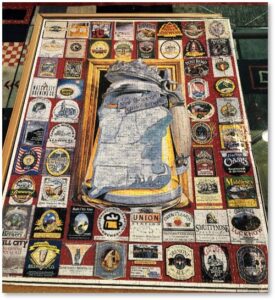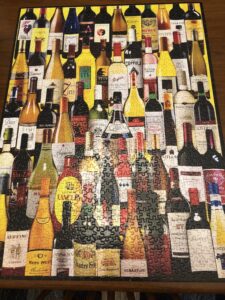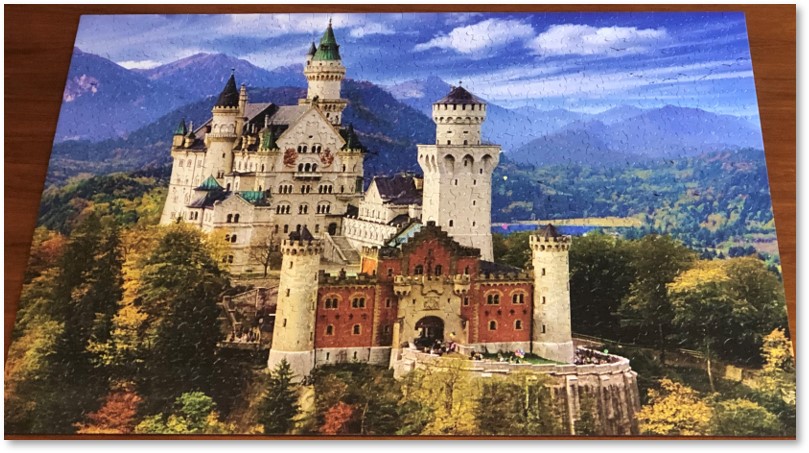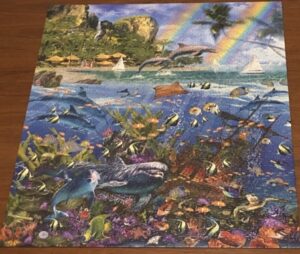January is National Puzzle Month and I want to celebrate all those folks who have used jigsaw puzzles to survive the Pandemic, the Delta Variant and the Omicron Upsurge.
Covid-19 and Jigsaw Puzzles
 I always loved jigsaw puzzles but rarely had time to spend on them. When I could take time from work, family, housework, cooking, and exercise, I usually spent it reading. Retirement gave me more time but I spent most of that writing another novel and getting some short stories published.
I always loved jigsaw puzzles but rarely had time to spend on them. When I could take time from work, family, housework, cooking, and exercise, I usually spent it reading. Retirement gave me more time but I spent most of that writing another novel and getting some short stories published.
Then came Covid-19 with its lockdowns. What to do when you can’t go anywhere? Like millions of people, I dragged a jigsaw puzzle out of storage and hauled it downstairs. My husband had never done a jigsaw puzzle (!) but he was game. We spread it out on the coffee table and dug in while the TV reported the latest news about a world that seemed to have disappeared from real life.
Swaps and Preferences
We finished that one—New England beers—and went on to another. I began swapping puzzles with a friend and we have a puzzle swap at the clubhouse in our condo community. I have also shipped some to my granddaughters, who enjoy doing jigsaw puzzles with their mom.
Over time, we developed preferences for some puzzle brands while avoiding others. My husband likes montages of pictures, signs and logos from White Mountain Puzzle Co. while I prefer landscapes and designs.
I was unpleasantly surprised to find I disliked puzzles with images of great paintings. You would think someone who likes art as much as I do would jump all over these. Instead, I found their colors muddy and assembling them difficult. (The only one we ever just gave up on was Van Gogh’s Yellow Café.)
Heads Down, Ears Open
Jigsaw puzzles got us through the first Pandemic round and the 2020 Presidential Campaign, plus the first impeachment. They were especially good for campaign speeches and the debates. We learned that you don’t need to see the talking heads to follow what they are saying.
After that came the January 6 Insurrection and yet another Presidential impeachment. We kept our heads down and our ears open as we worked our way through multiple jigsaw puzzles while following the national news.
How Jigsaw Puzzles Are Made
The Puzzling Cut website tells me there are four steps in making a jigsaw puzzle:
Designing the puzzle and laying it out: Some companies use existing works of art or photographs. This may be a single image or a collage of images. Others use their own in-house artists to create the designs. Cobble Hill provides a good video tutorial on how the design process works.
Printing the design: This may involve digital printing or lithographic printing processes. Although lithography was most common in the past, most companies use technology to print digitally today. They then laminate the printed design onto cardboard.
Cutting the puzzle into pieces: I find this part most interesting. Companies can use one of three methods to cut the puzzle—scroll saw/jigsaw, die-cutting, or laser cutting. In the beginning of the industry, wooden puzzles demanded sharp saws to cut. High-tech laser cutting gives more accuracy and precision but is more expensive.
Thus, most companies use the die-cutting process today. Razor-sharp steel rule dies get individually formed into the shapes of the pieces. These rule dies are assembled and placed under a die-cutting press that punches them through the paper.
Disassembling and packaging the pieces: Once the puzzle has been cut, it gets dissembled, placed in a plastic bag and put into the cardboard box you bring home.
If you’re curious, you can watch the whole process of creating a jigsaw puzzle on YouTube. Should this all sound wonderfully automated and fast, keep in mind that it takes about a year to create a puzzle.
Puzzle Advantages
Jigsaw puzzles offer several advantages in addition to entertainment and diversion. They teach visual recognition, spatial relationships, color identification, pattern matching and how to use negative spaces. Their images can also expose children to places around the world, buildings, paintings, animals, food, birds, or insects that generate curiosity. The kids can learn a lot while putting the puzzle together. You, might, too.
If you have never done a jigsaw puzzle, haven’t attempted on in years, or would like to take your puzzle work to the next level, try this video of 10 Expert-Level Tips.
We all have our preferences. I like putting the frame together first and then focusing on patterns or color groups while my husband starts with patterns. When I get to a section that has little in the way of pattern, I look at it upside down and work on the shapes of the pieces alone. And at the end, I sort the pieces by shape. Some folks do this from the start but that seems tedious to me.
The Finished Jigsaw Puzzle
Every time we finish a puzzle, we take a picture of it and put it in the Puzzle album on my phone. Sometimes I share the image with my friends on Facebook.
Then we break it up, put the pieces in a plastic bag, and put the puzzle aside to swap or give to someone else to enjoy. Counting the pictures in my puzzle album, I see we are on puzzle #40—a beach scene with a Volkswagen bus.
National Puzzle Month has three more weeks. That’s plenty of time for you to pick up a jigsaw puzzle and try your hand. Have fun!





